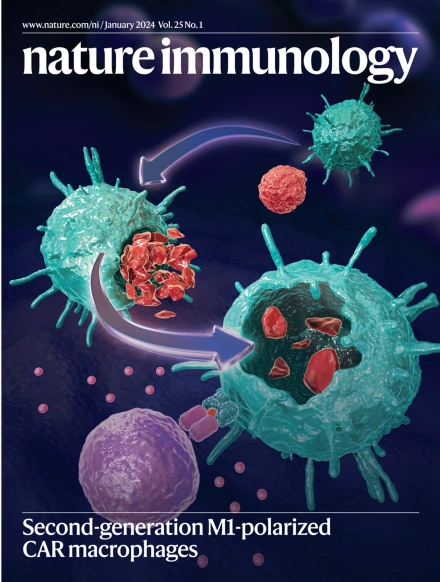An SSTR2–somatostatin chemotactic axis drives T cell progenitor homing to the intestines
IF 27.7
1区 医学
Q1 IMMUNOLOGY
引用次数: 0
Abstract
Progenitors of intraepithelial T cells (IELps) migrate from the thymus to the intestines after birth where they develop into unconventional TCRγδ and TCRαβ lymphocytes in a process of extrathymic lymphopoiesis within cryptopatches. Mechanisms of IELp migration have remained unclear. Here we show that thymic IELps express the somatostatin receptor SSTR2, which contributes to their homing to the gut. IELp homing is Sstr2 dependent and correlates with neonatal induction of Sst encoding somatostatin in neuroendocrine and lamina propria stromal cells. The SSTR2 ligands somatostatin and cortistatin attract IELps in chemotaxis assays and somatostatin triggers IELp binding to the mucosal vascular addressin MAdCAM1. T cell transduction with Sstr2 confers homing to the neonatal colon. Human fetal thymic IELp-like cells express SSTR2 and intestinal stromal cells express SST at the time of initial T cell population, suggesting conserved mechanisms of progenitor seeding of the developing intestines. These results reveal an unexpected role for the SSTR2–somatostatin axis in early immune system development and describe a new role for a small peptide hormone G-protein-coupled receptor in developmental lymphocyte trafficking. Progenitors of intraepithelial T cells (IELps) migrate from the thymus to the intestines after birth where they can develop into unconventional intraepithelial lymphocytes. Here Ocon et al. find that the neuroendocrine peptide hormone somatostatin controls the migration of committed SSTR2-expressing IELps from the thymus to the immature gut.


sstr2 -生长抑素趋化轴驱动T细胞祖细胞归巢到肠道
上皮内 T 细胞(IELp)的祖先在出生后从胸腺迁移到肠道,在隐窝内的胸腺外淋巴细胞形成过程中,它们发育成非常规的 TCRγδ 和 TCRαβ 淋巴细胞。IELp 迁移的机制仍不清楚。在这里,我们发现胸腺 IELp 表达体生长抑素受体 SSTR2,这有助于它们向肠道归巢。IELp的归巢依赖于SSTR2,并与新生儿期诱导神经内分泌和固有膜基质细胞中编码体生长抑素的Sst相关。在趋化试验中,SSTR2 配体体生长抑素和可体生长抑素会吸引 IELp,体生长抑素会触发 IELp 与粘膜血管地址素 MAdCAM1 结合。用 Sstr2 转导 T 细胞可使其归宿到新生儿结肠。人类胎儿胸腺 IELp 样细胞表达 SSTR2,而肠道基质细胞在初始 T 细胞群时表达 SST,这表明发育中肠道的祖细胞播种机制是一致的。这些结果揭示了SSTR2-somatostatin轴在早期免疫系统发育中的意外作用,并描述了小肽激素G蛋白偶联受体在淋巴细胞发育迁移中的新作用。
本文章由计算机程序翻译,如有差异,请以英文原文为准。
求助全文
约1分钟内获得全文
求助全文
来源期刊

Nature Immunology
医学-免疫学
CiteScore
40.00
自引率
2.30%
发文量
248
审稿时长
4-8 weeks
期刊介绍:
Nature Immunology is a monthly journal that publishes the highest quality research in all areas of immunology. The editorial decisions are made by a team of full-time professional editors. The journal prioritizes work that provides translational and/or fundamental insight into the workings of the immune system. It covers a wide range of topics including innate immunity and inflammation, development, immune receptors, signaling and apoptosis, antigen presentation, gene regulation and recombination, cellular and systemic immunity, vaccines, immune tolerance, autoimmunity, tumor immunology, and microbial immunopathology. In addition to publishing significant original research, Nature Immunology also includes comments, News and Views, research highlights, matters arising from readers, and reviews of the literature. The journal serves as a major conduit of top-quality information for the immunology community.
 求助内容:
求助内容: 应助结果提醒方式:
应助结果提醒方式:


